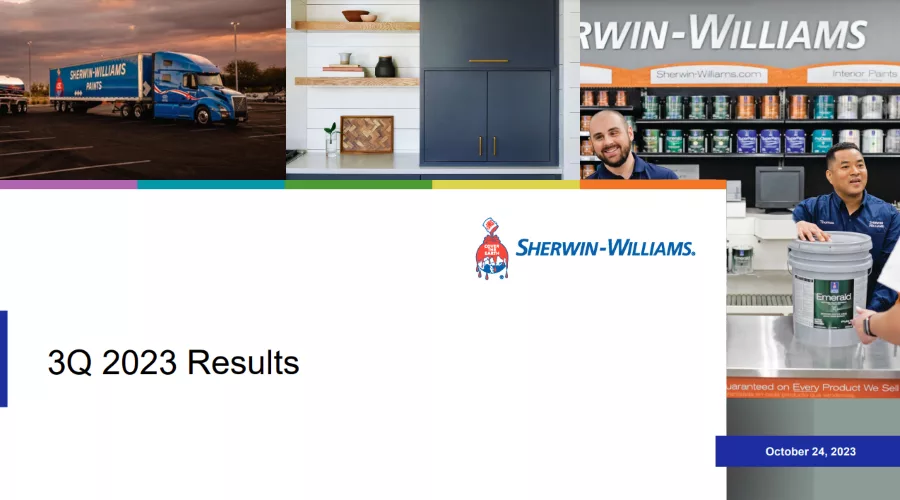The Sherwin-Williams Company Reports 2023 Third Quarter Financial Results

Photo courtesy of the Sherwin-Williams Co.
The Sherwin-Williams Co. announced its financial results for the third-quarter ended September 30, 2023. All comparisons are to the third-quarter of the prior year, unless otherwise noted. Reportedly, consolidated net sales increased 1.1% in the quarter to $6.12 billion; net sales from stores in the United States and Canada open more than twelve calendar months increased 3.0% in the quarter; diluted net income per share increased 12.6% to $2.95 per share in the quarter compared to $2.62 per share in the third-quarter 2022; adjusted diluted net income per share increased 13.1% to $3.20 per share in the quarter compared to $2.83 per share in the third-quarter 2022; and Earnings Before Interest, Taxes, Depreciation and Amortization (EBITDA) in the quarter increased 12.6% to $1.27 billion, or 20.7% of net sales.
“Sherwin-Williams delivered strong third-quarter results in an environment where demand remained highly variable by end market and region, and against a challenging prior year comparison,” said John G. Morikis, chairman and CEO. “Consolidated net sales were within our guidance range, and consolidated gross margin of 47.7% expanded significantly both sequentially and year-over-year driven by pricing discipline and moderating raw material costs.”
Morikis continued, “As we previously indicated, we have deliberately chosen to continue investing at this time in multiple growth initiatives and solutions for our customers, which is reflected in higher SG&A costs in the quarter compared to a year ago. While we executed on these initiatives, we continued to create shareholder value as adjusted diluted net income per share and EBITDA grew by double digit percentages, and we returned $566 million to our shareholders through dividends and share repurchases during the quarter.”
Consolidated net sales reportedly increased primarily due to selling price increases in all segments, which impacted sales by a low-single digit percentage, and modest net benefit from acquisitions and divestitures and favorable currency translation rate changes. This growth was mostly offset by a low-single digit volume decrease primarily driven by the consumer brands and performance coatings groups.
Income before income taxes increased primarily due to benefits from selling price increases in all segments and moderating raw material costs. These factors were partially offset by lower fixed cost absorption in consumer brands due to lower production volumes, lower sales volumes in the consumer brands and performance coatings groups, continued investments in long-term growth strategies and higher employee-related expenses. Increased costs within the administrative segment, including environmental expense and asset disposals, also reduced Income before income taxes.
Net sales in the consumer brand group decreased primarily due to the divestiture of the China architectural business, which reduced sales by approximately 3.0% in the quarter. Mid-single digit volume declines were partially offset by selling price increases, which impacted sales by a mid-single digit percentage. Lower sales volume growth in North America and Asia were partially offset by higher sales volume growth in Latin America and Europe. Consumer brand group segment profit decreased primarily due to lower sales volume and lower fixed cost absorption due to lower production volumes. This was partially offset by benefits from selling price increases and moderating raw material costs. Acquisition-related amortization expense reduced segment profit as a percent of net external sales by 190 basis points in the third-quarter of 2023, compared to 210 basis points in the third-quarter of 2022.
Net sales in the performance coatings group decreased primarily due to high-single digit volume declines, partially offset by selling price increases, which increased net sales by a low-single digit percentage. Incremental sales from acquisitions increased net sales by 3.1% in the quarter, while currency translation rate changes added 1.9% to net sales. Performance coatings group segment profit increased primarily as a result of moderating raw material costs and selling price increases, partially offset by lower sales volume and increases in selling costs. Acquisition-related amortization expense reduced segment profit as a percent of net external sales by 290 basis points in the third-quarter of 2023, compared to 280 basis points in the third-quarter of 2022.
The full report can be accessed here.
Looking for a reprint of this article?
From high-res PDFs to custom plaques, order your copy today!




